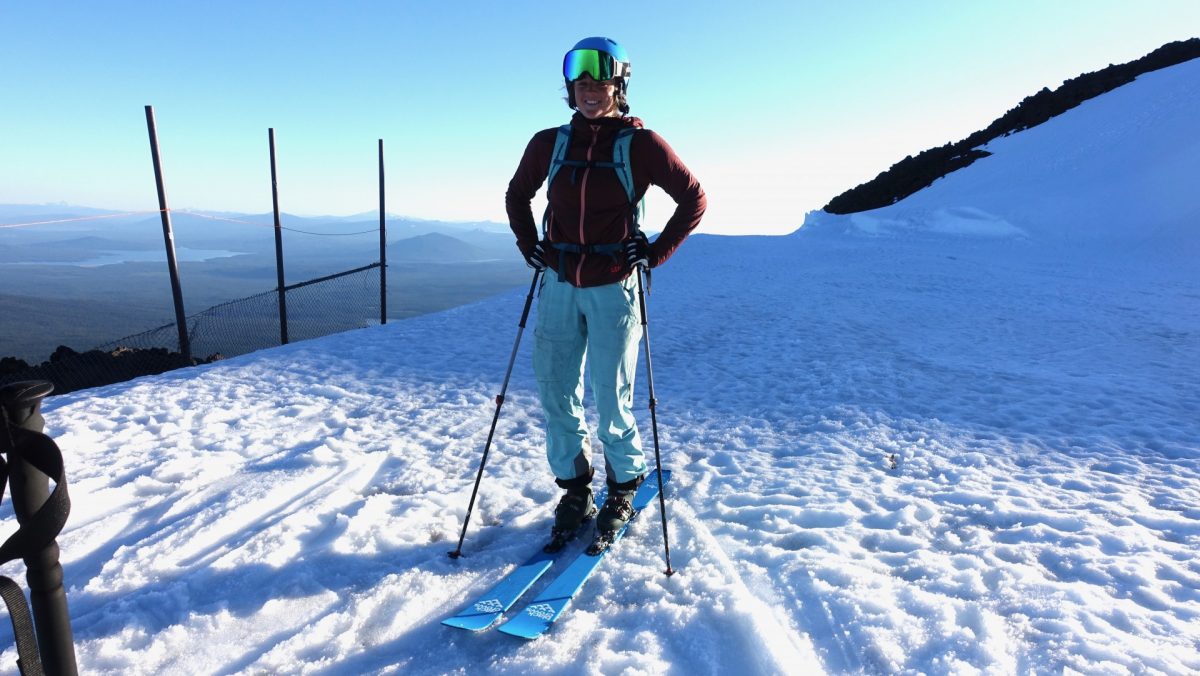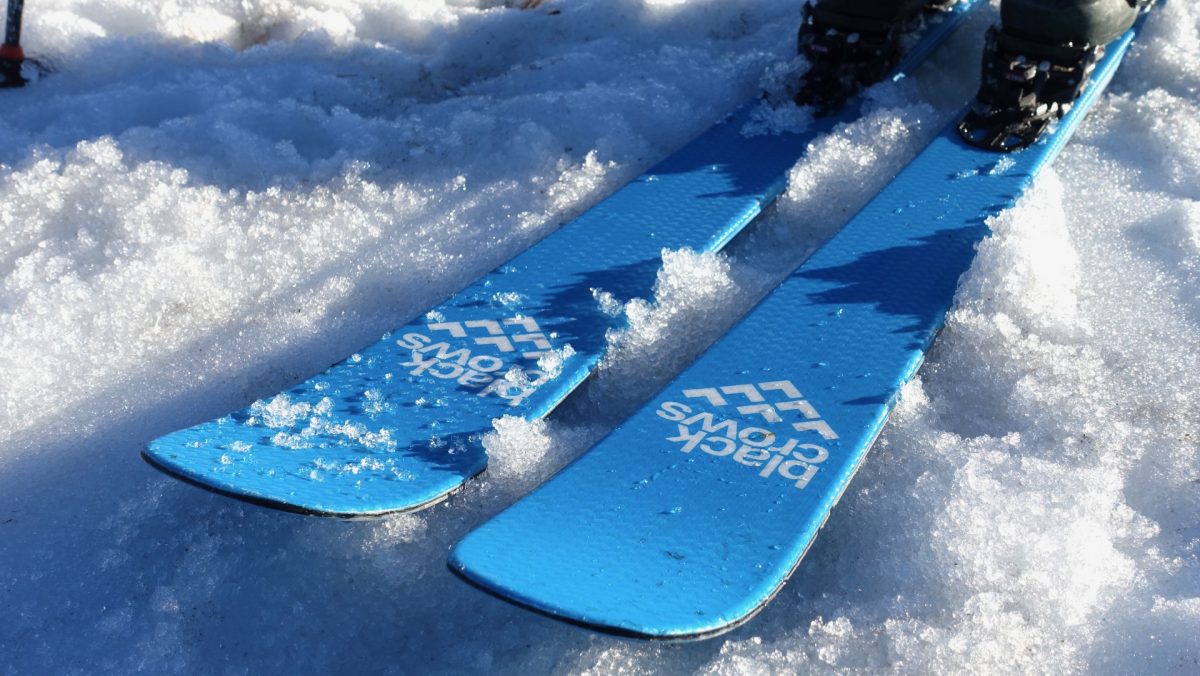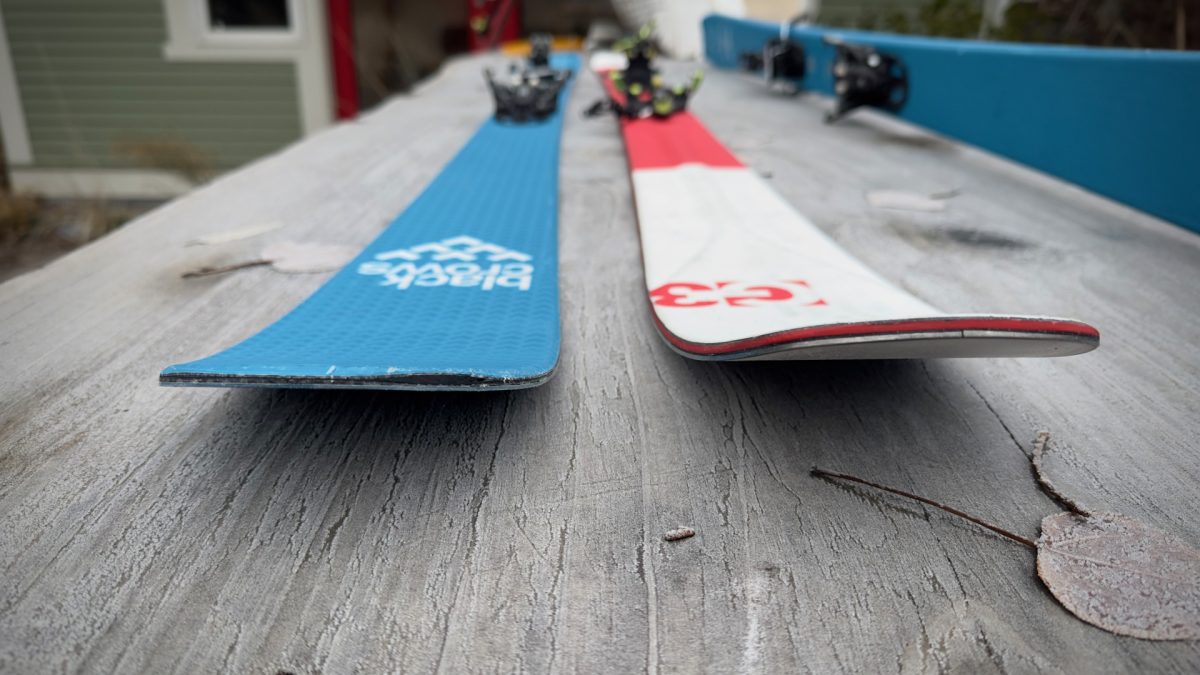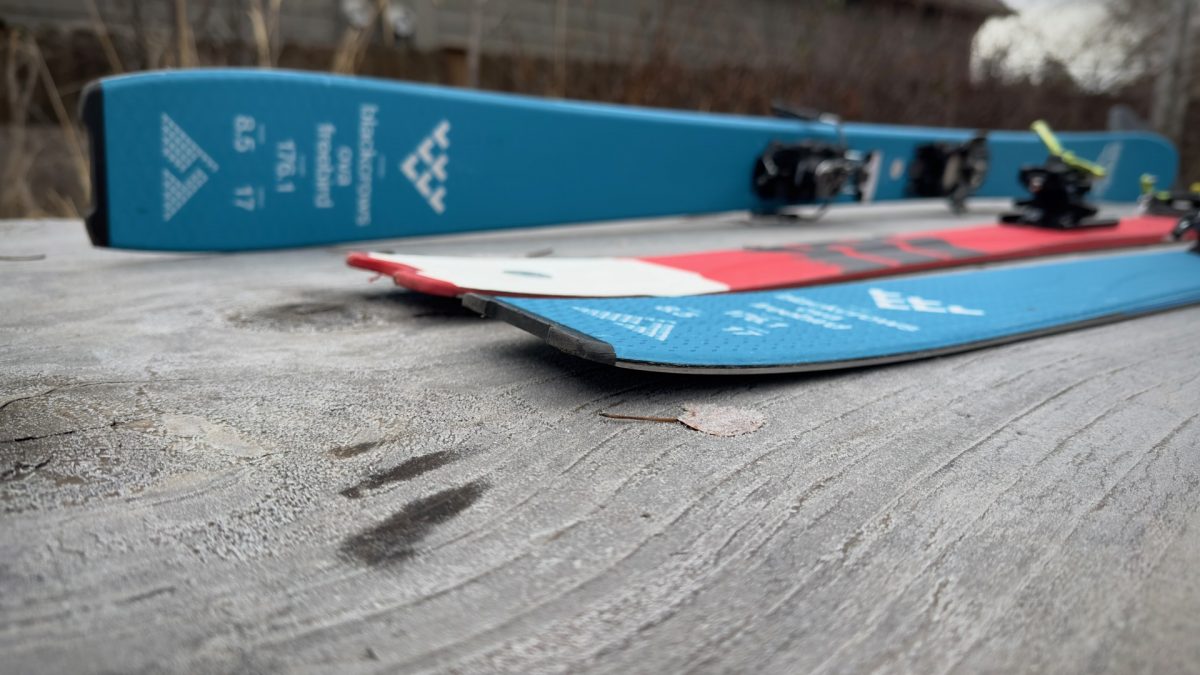
Annabel Hagan finding some joy in hauling lighter skis up the local volcano. The ski crafters at Black Crows are on their third iteration of the Ova Freebird, an 85mm underfoot ski in the middle of the company’s touring Freebird lineup.
The Black Crows Ova Freebird presents an 85mm underfoot ski with a friendly personality able to take on big spring skiing objectives and keep the weight to a minimum.
The ski crafters at Black Crows are on their third iteration of the Ova Freebird, an 85mm underfoot ski in the middle of the company’s touring Freebird lineup. The Ova is sandwiched between the Orb Freebird at 90mm (read our review) and the Mentis Freebird at 80mm underfoot (read our review here), respectively. Like most ski companies in the backcountry space, manufacturers often populate that space in tidy 5cm increments. There are many skis which means many options. And so these questions arise, what might make the Ova stand out and who should be eyeing this cerulean blue ski?
The Mentis FB is a traditional enough ski with a stiffish front and tail end and some camber underfoot to make good use of the ski’s longer turn radius (19m), making this a great corn ski for those GS turn lovers. The Ova FB, on the other hand, with its slightly wider waist and tip, can venture into slightly deeper and more variable snow. Yet, the Ova knows its lane; it is not a deep powder ski, and it is not a go full-throttle burn through chunder freeride plank. This ski does have ambitions; they are just more strictly defined.
Black Crows claim it has stiffened the newest iteration of Ova FB. Relatively speaking, we agree — the 2022-2023 version flexes stiffer. But here’s the catch, the tip isn’t overly stiff for those seeking a playful, forgiving, and easy-to-initiate plank. Engaging and steering the ski’s front end is straightforward. For those thinking light and stiff skis are twitchy, you shouldn’t experience those sensations with the Ova. Those preferring gentle turns at slower to moderate speeds will love the Ova’s buttery initiation and follow-through.

The Ova Freebird presents modest tip rise. Yet the front end’s flex allows the ski to smooth out less than perfect snow in some conditions.

The Ova Freebird on the left and the G3 FINDr 86 on the right. The FINDr 86 offers a bit more tip rise, whereas the Ova offers a softer front end.
The Ova’s tip has rocker built in, but it is traditional in scope. The ski’s ability to ride over less-than-ideal snow stems from the tip’s softer flex, not an early and aggressive tip rise. In contrast, and evident in the photo below, the stiffer all-around G3 FINDr 86 has more tip rise than the Ova, yet a stiffer front end. The tails of the two skis are similar in their profile (read pretty flat with some gentle rise), with the G3 again slightly stiffer in the rear section. Below the boot, the Ova has minimal camber; call it roughly 2mm.
These skis are not bucking broncos. I wouldn’t call them poppy or energetic skis; they are predictable and calm and can take a bit of rowdiness. But tempered rowdiness. Consider the Ova more silky smooth in corn snow, slightly softened icy snow, windboard, and 3 to 4″ of wind-affected snow. In these conditions, the Ova Freebird delivers quick linking or wider turns with no chatter and an easy release.
Reading between the lines, if you seek a rigid steep skiing tool and the words ski mountaineering make you restless, the Ova might not satiate your appetite for no fall zone jump turns. For a true steep skiing spring ski, where conditions warrant a stiff tip and tail for solid edge hold and jump turns, the Ova might be out of its element — if you are a Black Crows devotee, the Orb or Mentis fill that void. For those looking for a wider BC plank, the Navis Freebird holds serve in those conditions too.
I used the Dynafit TLT X (check out our review) and the Salomon S/Lab MTN Summit (check out our review) with the Ova. The TLT X has a softer and more progressive flex, while the S/LAB is stiffer all around. Both boots work well with a ski like the Ova. The point is this: if you use a softer, lighter boot (1kg class), you’ll be paired up nicely with the Ova. These do not require or remotely warrant a beefier four-buckle boot, even in unconsolidated snow — just remember to check your speed when conditions call for some caution.
Ending Thoughts
The test/review Ova Freebird arrived with an adjustable (rental) Marker Alpinist binding with brakes. With the binding, the ski weighs 1720g. Sniffing around the web, we find the binding alone weighs 550g. 1720g-550g= 1170g for the ski. As an on-resort uphilling setup, pairing a light binding with the Ova would make sense. You’ll also have a playful ski at home off-piste in the Ova. The qualifier here is that the Ova will remain forgiving and friendly to a point. This ski has many lanes, but they are defined by mellower conditions and skiers staying within the prescribed speed limit for the day’s objectives. I could see this ski as a spring traverse tool too. But if I carry 30 pounds or more on my back, I want more rigidity in the front end than the Ova offers.
All those attributes we might assign a lighter and stiffer ski, like twitchy and chattery, would miss the mark with the Ova. If you’ve been frustrated by a lighter and skinnier ski that needs to be skied too aggressively and too intentionally for your style, the Ova Freebird might suit you.
Ova Freebird Stats
Size Reviewed: 176cm
Claimed Weight: ~1200g
Dimensions (mm): 126-85-109
Radius: 17m
Sizes Available (cm): 156, 163, 170, 176, 182
Construction: Semi Cap, ABS Sidewall, Titanal insert in binding mount zone
Core: Paulownia, mix of carbon and fiberglass
Price: $699.95
Shop for the Black Crows Ova Freebird.
We sent this ski out with a few other skiers over the spring and fall/early winter to get some more eyes on these boards. Below are their thoughts.
Ambrose Su:
First, I am a big fan of the 85mm waist, 17m turn radius skis, in general: It is a sweet spot for AT( and alpine!), providing easy turning, good edge grip, generally a good touring weight, and enough float most of the time. For lighter skiers, this could be the quiver killer if such a thing exists.
Here in Bend, 85mm works great most of the time. I will pull out wider boards when new snow is more than about 4″, which can be often here during a good winter. It’s not so much about the turns, as I don’t mind sinking a bit, but rather on flatter terrain with deep and often wet snow, one needs to stay on top just to get to the bottom.
The rest of the time, the mid-quiver 85/17 recipe is very versatile. Of course, with a full quiver, every width has particular advantages. As a first-time setup, there is a lot to be said for getting something in the 85-95mm range. The 105s on firmer snow seem like overkill and not as playful or fun as a narrower ski.
I have used a pair of Ova Freebirds as my all-around AT ski for the past 3 yrs. I was excited to try the latest version and see what changes I might feel. There is a noticeable difference between the 170s I have vs. the 176 demos. My old Ovas are 122/85/105, 17 Radius. The new 176’s measure 125/85/109, still a 17m radius. I like my old Ova’s most of the time, I do notice they can feel a bit soft on firmer snow. But they hook up nicely and are a lot of fun. My limited time on the new Ova’s ( Aug 5th!) was on softened corn with a few firm spots. The sun cups were softened enough that they weren’t too jarring. I trusted the new Ova’s enough to take the first turns on them into the Cirque Bowl, which can be 40 degrees in places. They turned easily enough, not quite as easily as my 170s, but still, they were easy to get used to. The skis inspired enough confidence to push them right away.
The new Ovas felt more stable on the steep and firmer areas but didn’t dig in on the soft corn areas. They linked short GS turns over sun cups with stability and instinctively turned. The bit of extra weight to stiffen them up was a good compromise.
Later that afternoon, I let them rip a bit more on one remaining field of continuous 1000′ vertical snow. With a solid bite, they allowed bigger GS turns on the sun cups and felt a little more alpine than my older, shorter, softer Ovas.
The Fall Update:
Compared to when I last skied these in August on firm corn snow, I got a chance to experience the new Ovas in different PNW Bachelor conditions.
1. In 6-8″ of pretty good Bach powder, they skied intuitively, turned easily, and floated well enough for an 85mm ski. Not quite as playful or floaty as some older Dynafit Manaslu 95mm skis, but close.
2. Two days later, good powder in places, skis are again fun and solid. However, they seemed a bit hooky and inconsistent in places where snow was transforming powder between areas of icy wind-scoured snow. Probably any ski this width would do this; more width would have made the transitions less abrupt. Compared to my previous version in 170, the extra length and stiffness contributed to my feeling of this.
3. A week later, I skied the Ovas on a machine-rolled run. Here the skis were in their element. Stable on plow-tracked ice chunks, open slalom style turns easy to initiate, shovels solid enough to bite and arc around. Here the length and extra stiffness were welcome and useful.
4. After using the new Ovas across a broad range of conditions, they are great on firm or even icy snow and consistent powder. Under trickier transitional conditions, a bit wider ski would make sense.
Annabel Hagen (Jackson Hole local living in Bend for the summer):
Growing up in Jackson, WY, unless you’re racing gates, it has always been an unspoken competition to see who can have fatter skis. Beyond a fleet of cross-country skis, I have never skied on something skinnier than a 102mm. Taking full advantage of the late Pacific Northwest snow, I spent a few weekends in June skiing volcanoes, something new to me.
On my first climb-ski up Mt. Hood with a few friends, looking around, I noticed the Jackson-kid fat ski trend prevailed. One partner was on 120mm Ben Chetlers, and another on the 107mm Corvus Freebird. I would have been there with them if I hadn’t been able to ski the Ovas. It was my first time skiing real PNW terrain and my first time on narrower skis — so the offer to ski the Ovas came with caution, but I was excited to try the boards out.
For background, I am used to skiing on the Black Crows Corvus Freebird (107mm, 180cm) and the Navis Freebird (102mm, 173cm). In full transparency, I picked these skis because I liked the color, and they were in an end-of-season sale. Color aside, my penchant for sweet hues paid off; I like the skis.
My first introduction to the blue ski, the Ova, was skinning up Mt. Bachelor. Compared to 107mm underfoot, these 80mm 176cm skis felt like feathers on my feet. Making the switch to a narrower ski took a little getting used to, but I will admit they are quite fun. They are fast and easy to set into the snow on the uphills. The ski’s themselves aren’t very stiff tip to tail but felt balanced and stable on the remains of what were groomers the month prior.
Once I realized the sweet spot was in the middle of the ski and made more intentional turns to get onto the edge, they made fun and snappy turns. The short turning radius made for easy slalom-like turns, while for me, opening up longer arc turns felt a little wobbly and less directional than what I am used to, but still, manageable.
Back to Mt Hood.
The Ovas are light and easy to maneuver while skinning up the mountain: the crew of 100mm+ were audibly envious of how easy skinning on ice was.
Bumping up a notch in terrain and exposure, skiing the Ovas down the Old Chute on Mt. Hood, the skis felt solid. I found them to ski well in each condition we encountered that day.
In true Mt. Hood fashion, we waited for the first pitch to soften but got impatient and started the descent. The soft camber of these skis made jump turns doable but would be challenging on anything icier. This aspect of the ski was more forgiving as the snow softened further down the mountain. We finished off the day poaching a slalom course at the bottom of the mountain, and carving around these gates highlighted the potential of these skis – quick and short turns.
From 40-degree icy pitches to amateurish “slapping” slalom gates in the slush, these skis are a great intermediate condition ski. They require a little more agility to make them move but are worth the extra thought for their versatility. They would be limited in deep powder or bulletproof ice but are a perfect lightweight spring ski for most conditions.
Jason Albert comes to WildSnow from Bend, Oregon. After growing up on the East Coast, he migrated from Montana to Colorado and settled in Oregon. Simple pleasures are quiet and long days touring. His gray hair might stem from his first Grand Traverse in 2000 when rented leather boots and 210cm skis were not the speed weapons he had hoped for. Jason survived the transition from free-heel kool-aid drinker to faster and lighter (think AT), and safer, are better.


